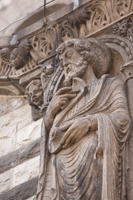- Title Page
- Introduction
- Boston Globe —Brief History
- Baron—A New Face
- An Investigation is Born
- The Spotlight Team
- The National Picture
- The "Most Catholic City"
- Cardinal Law
- The Paper and the Cardinal
- The Globe and Boston's Catholics
- Father Geoghan Case
- Starting to Dig
- Organizing the Files
- The Database Grows
- When the Story Gets Personal
- Reporting Your Culture
- Potential Backlash
- Rezendes Gets a Scoop
- Publish or Pause?
The "Most Catholic City"

A statue outside of Trinity Church.
Courtesy iStockphoto
If there was one place in the United States where a major investigation into the Catholic Church might cause an uproar, it was Boston. As Globe reporter Rezendes says, it was “the most Catholic major city in the country.” The three most populous US cities—New York, Los Angeles, and Chicago—had more Catholics, but Boston had the highest percentage. Of the 3.8 million people living in Boston’s metropolitan area in 2001, about 2 million were Catholic.
Boston ’s archbishop presided over an extensive network of parishes, schools, seminaries, convents, and hospitals. The job title alone conferred significant power, and for most of the 20th century, Boston’s larger-than-life archbishops had expanded the scope of the office to wield power well beyond the church, and well beyond Boston. “ The Boston Archdiocese is a uniquely American Catholic institution,” wrote a Minneapolis newspaper when the head of the archdiocese there was under consideration for the Boston job. “It is to the church what the New York Yankees are to baseball, Carnegie Hall to music, Broadway to theater.” [1]
It was not only the number of Boston’s Catholics that explained their special place in the imagination of Catholics nationwide; it was their history. Establishing themselves in the birthplace of American Puritanism, they had overcome persecution to rise to the highest levels of political, economic, and social power. In this sense, the story of Boston’s Catholics was also the story of Boston’s Irish. People of Irish descent represented more than a quarter of the city’s Catholics and an even higher percentage of its ruling class.
As successive waves of immigrants washed into Boston in the 1820s, the 1840s, and the early 20 th century, Protestants reacted with hostility. An anti-Catholic press flourished. In a city where jobs were scarce, signs saying NINA—No Irish Need Apply—hung everywhere. Faced with discrimination and spurned by the city’s Protestant-dominated institutions, Boston’s Catholics developed an intense bond with their priests, who helped the new immigrants pay rent, fill out citizenship papers, and form unions.
In the decades leading up to World War II, however, the fortunes of Boston’s Catholics turned. They demonstrated a knack for politics, built a strong parish system, and produced skilled leaders, such as William O’Connell, Boston’s first archbishop to be named cardinal. O’Connell (served 1907-1944) centralized power and built numerous churches, schools, seminaries, convents, and hospitals. A militant champion of Catholicism, he made no effort to cooperate with Protestants whose time, he said, had passed. His political power came to rival the governor’s. Nicknamed “Number One” by politicians, he could single-handedly determine the fate of legislation.
His successor was Cardinal Richard Cushing (served 1944-1970). A beloved populist who promoted interfaith cooperation, he offered a striking contrast to his feared, autocratic, non-ecumenical predecessor, but Cushing attained a stature that matched O’Connell’s. Ray Flynn, a former ambassador to the Vatican and former mayor of Boston, said "Cardinal Cushing or O'Connell, he could just put his arm around someone who was running for mayor, and that picture would be on the front pages of the papers, and it might register 40,000 votes.” [2]
Yet if the history of the church in Boston was a success story, it ran into a plot twist in the 1960s. It was then that the Boston Archdiocese—along with the Catholic Church virtually everywhere else in the US—went into decline. Rocked by social change, it struggled to maintain priests, parishioners, and authority among both Catholics and the population at large. In 1968, when Pope Paul VI issued his famous encyclical reaffirming the Church’s unconditional opposition to artificial birth control, it sparked widespread opposition from priests and laity alike. Catholics stopped attending mass or left the church altogether. Fewer priests entered the seminaries. Rejecting church teaching on birth control, couples had fewer children. While the church was invigorated in some locales by Latin American immigrants, it struggled to remain relevant to many of its members.
[1] Warren Wolfe, “Could Flynn be a savior in Boston? The Twin Cities archbishop might get the 'toughest job in the Catholic Church,'" Star Tribune , April 28, 2003.
[2] Pamela Ferdinand and Paul Duggan, “In Boston, Driven by Disillusionment; As Priests' Abuse Scandal Unfolds, Irish American Catholics Angrily Confront Church,” Washington Post , October 30, 2002.